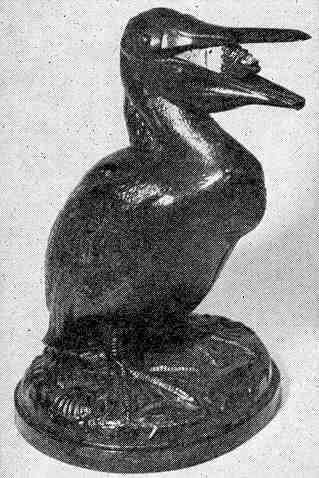Pelican Bank
by F.H. Griffith - HOBBIES Magazine - December, 1964
 In selecting the bank which is the
125th in the numerical classification an old saying is brought to mind, which
goes something like this: "A peculiar bird is the pelican — His bill holds more
than his belly can." True or false this does not apply to the Pelican Bank since the
inside of the pelican holds more coins than his bill ever will. However, as we shall see,
his bill does hold a surprise therein.
In selecting the bank which is the
125th in the numerical classification an old saying is brought to mind, which
goes something like this: "A peculiar bird is the pelican — His bill holds more
than his belly can." True or false this does not apply to the Pelican Bank since the
inside of the pelican holds more coins than his bill ever will. However, as we shall see,
his bill does hold a surprise therein.
John Girard of Trenton, N.J., patented the Pelican Bank, October 15, 1878. He assigned the patent to the Trenton Lock & Hardware Company, also of Trenton, N.J. They manufactured the bank and made it practically identical to the five diagrams in the patent papers. It is a unique item, both in appearance and operation. As a matter of fact, on first seeing the bank one would not necessarily recognize it as a savings device, but rather as a figure for decorative purposes. Only the slot in the top of the head for insertion of coins indicates its being a bank. It is a very well made piece with fine detail and quite attractive. It bears mention at this point too that no markings of any kind are on the bank itself. So here we have a case where a bank was patented but no dates or anything else appear on the bank to identify it as being patented.
The Pelican Bank shown is in original mint condition. It is painted an overall very dark japanned color highlighted and mixed in with gold bronze. The eyes are red. The figure inside the pouch of the bill has a brown face and large red mouth with white teeth. The eyes are white with black pupils. He or she, as the case may be, has either a white turban or duster type hat on its head. The figure from this point on back is red. This figure has often been referred to as a Hindu, however, it could well be a Negro Mammy. The writer is inclined to believe it is the latter.
To operate the bank the top of the bill (open as shown in the picture) is pushed down. This in turn pushes the figure into the pouch where it locks in place. Pressing a coin into the slot in the top of the head releases the mechanism and the figure springs up into position pushing the top part of the bill open and thus exposing the figure as shown in the picture. The coin drops inside the body of the pelican. To remove accumulated coins it is necessary to take out two screws that hold the pelican to the base. The base, by the way, is very decorative with shells, fish, seaweed and the like thereon.
An advertising flyer from the late 1870’s or early 1880’s has considerable interest. This was issued by James M. Vance & Company, Hardware and Cutlery, 211 Market St., Philadelphia, Pa. This flyer pictures the Pelican Bank and the text is as follows:
The Ornamental Pelican
Savings Bank
Patented October 15, 1878
Combines Amusement,
Ornament and Utility
As a savings bank it is as useful as any that have been offered for the favor of the public.
The very neat mechanical trick by which the mocking face of the cashier appears when a coin is deposited is a source of perpetual surprise and amusement to young and old.
The bank is handsomely bronzed and is highly artistic in design and execution making it a desirable ornament for the bracket or mantle.
The form is novel and attractive and the reasonable price at which the bank is offered recommends it to buyers generally.
In closing it bears mention that the Pelican Bank was made with three different figures inside the pouch. There is the one shown in the picture herewith, another is an imp type representation thumbing his nose, and the third is that of a rabbit. In the writer’s opinion all three types are of approximate equal desirability, however, the imp thumbing his nose is the more common of the three.
